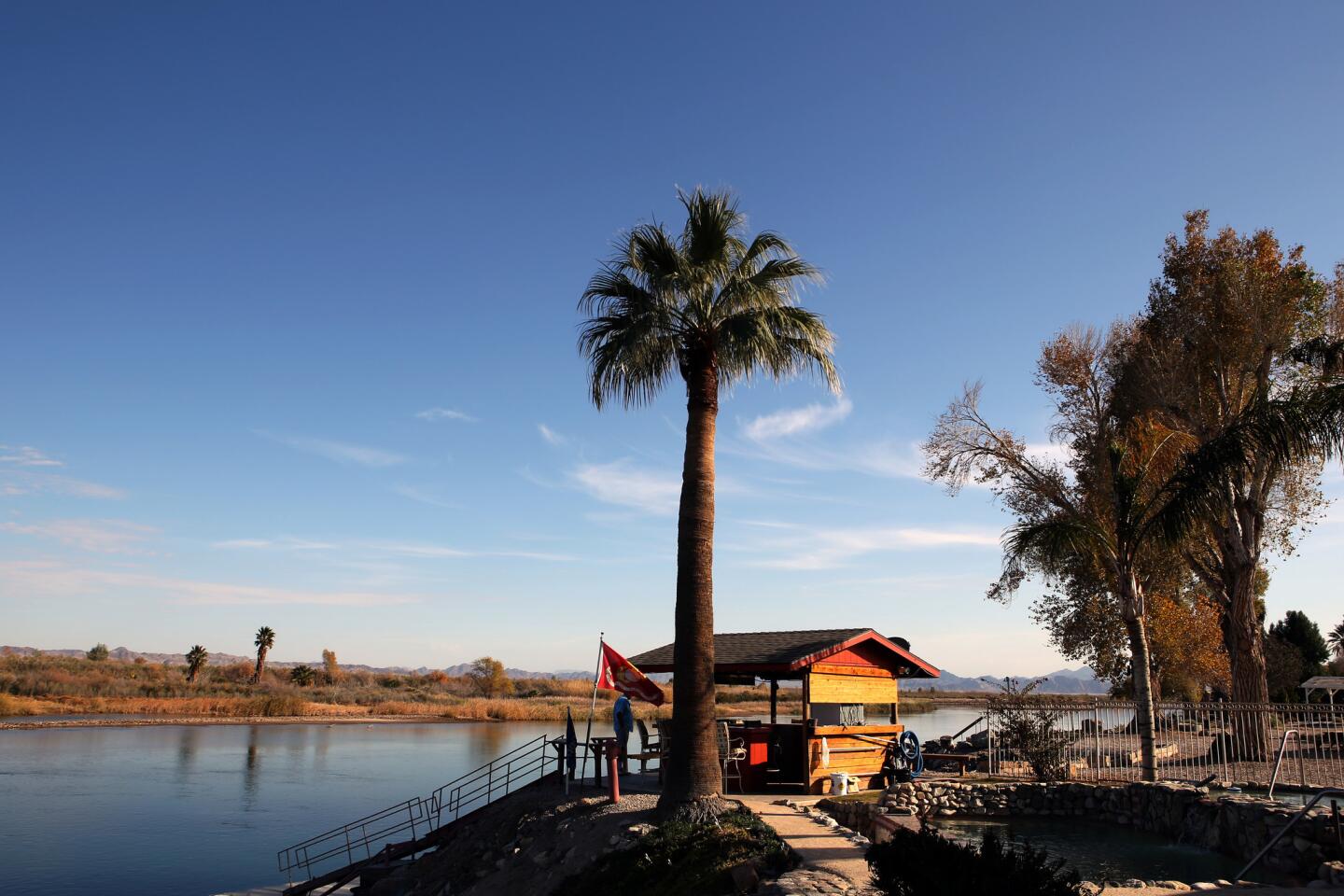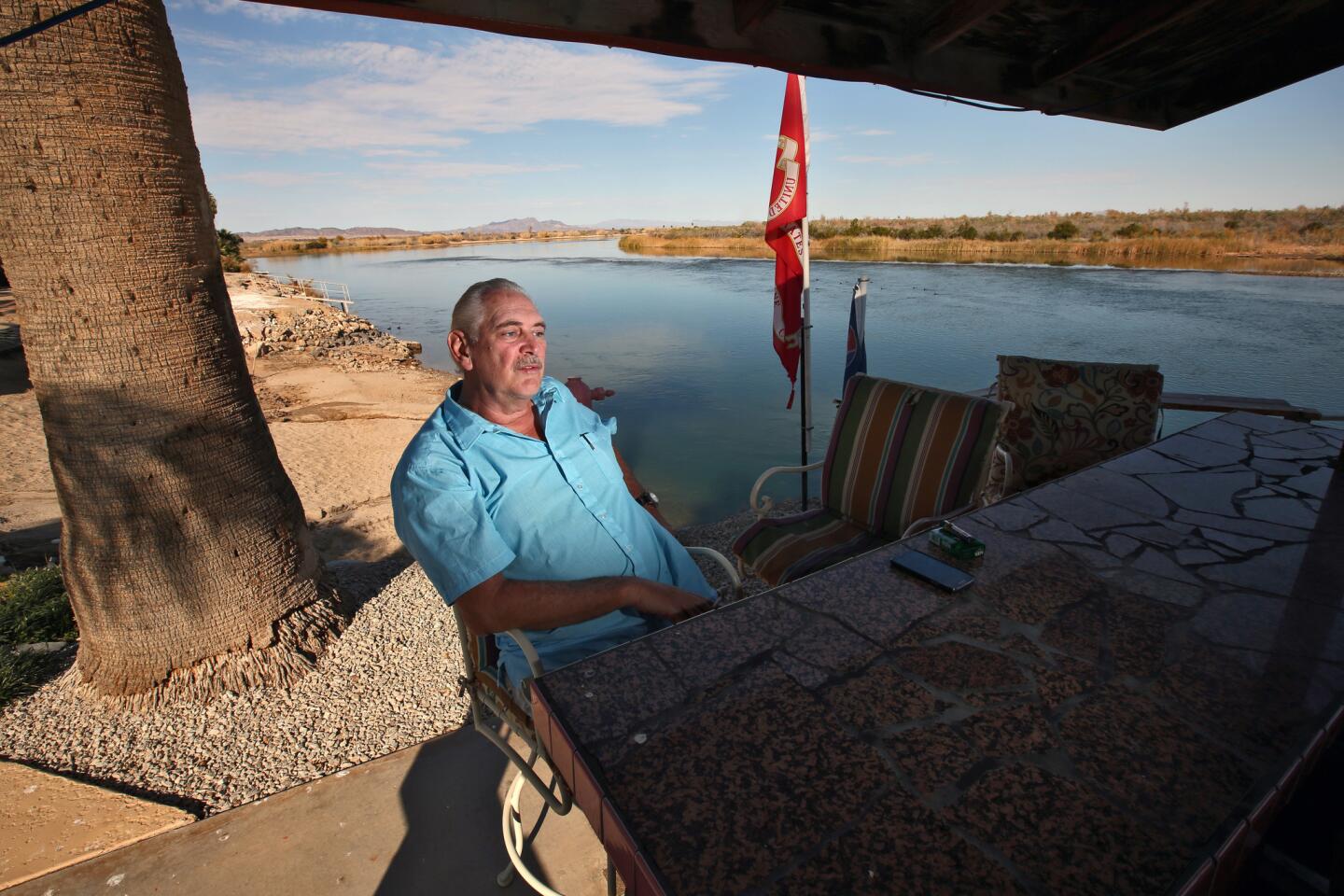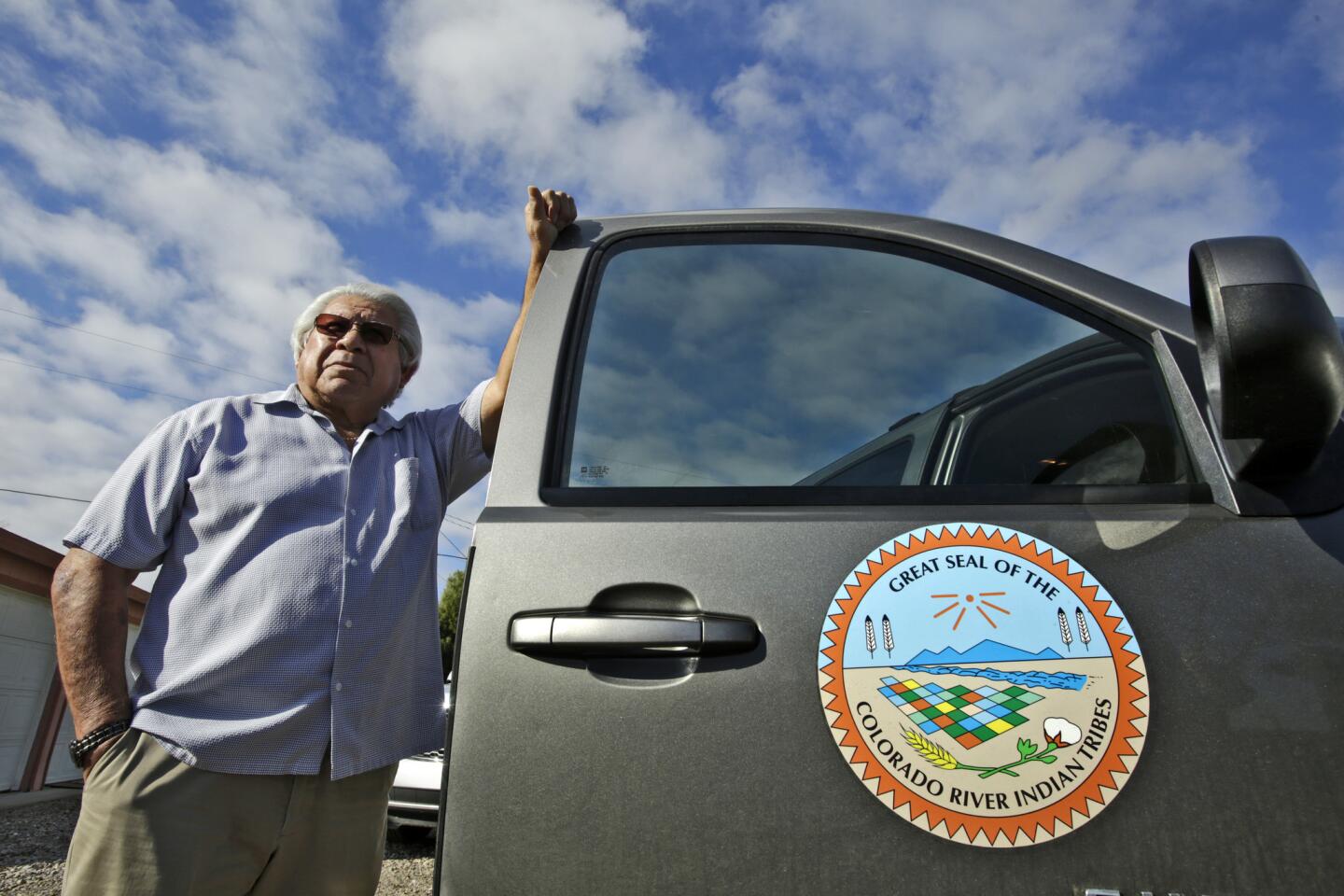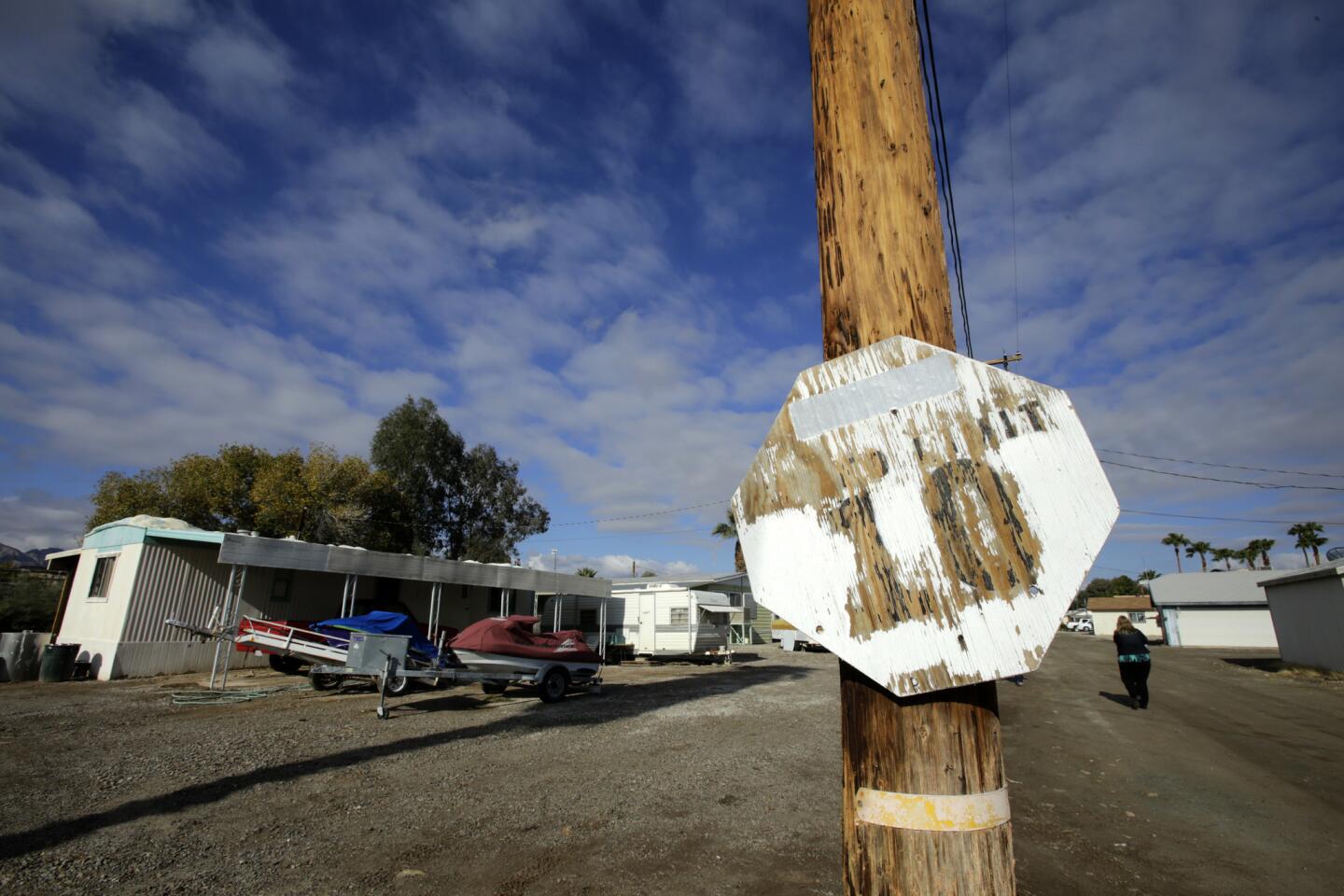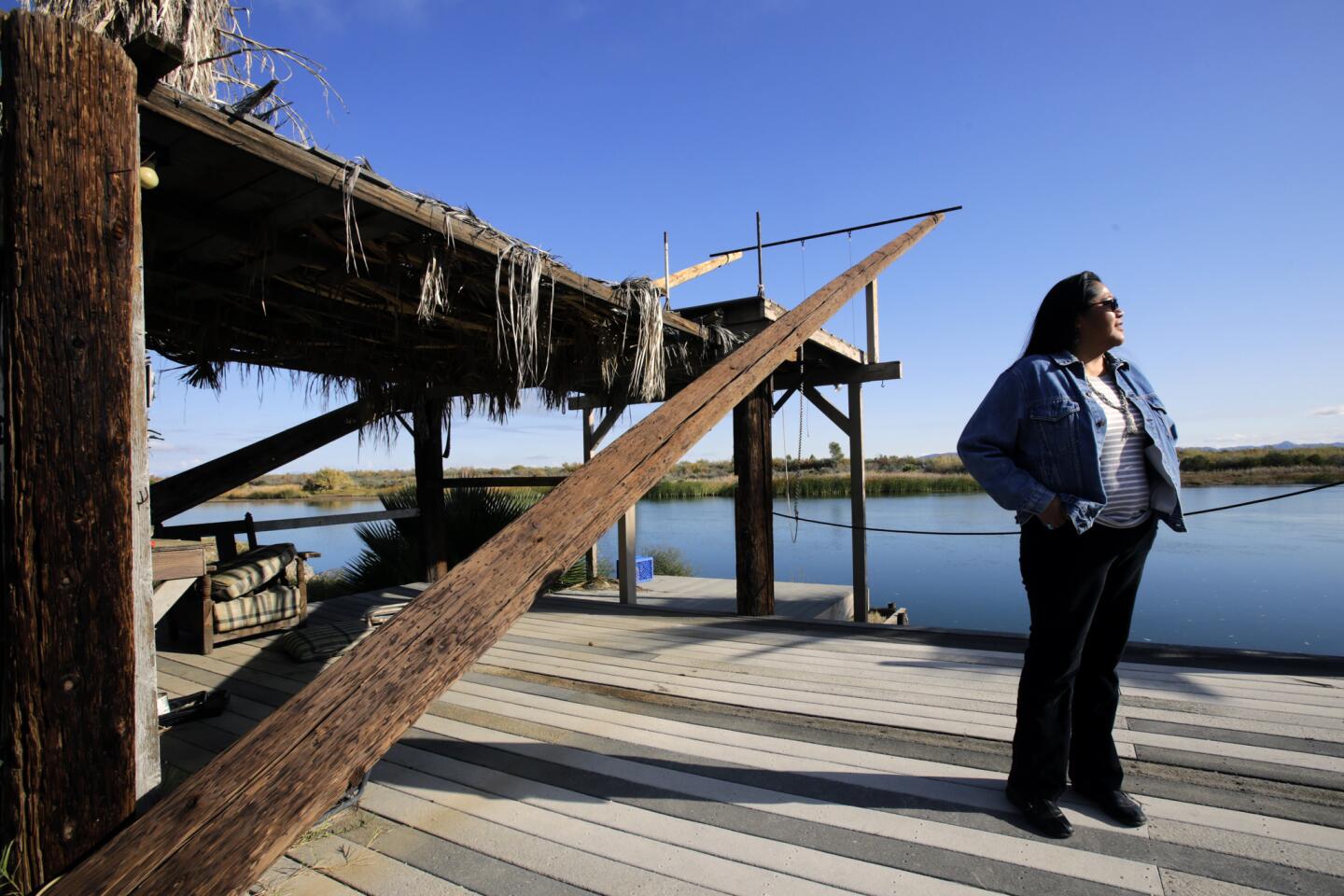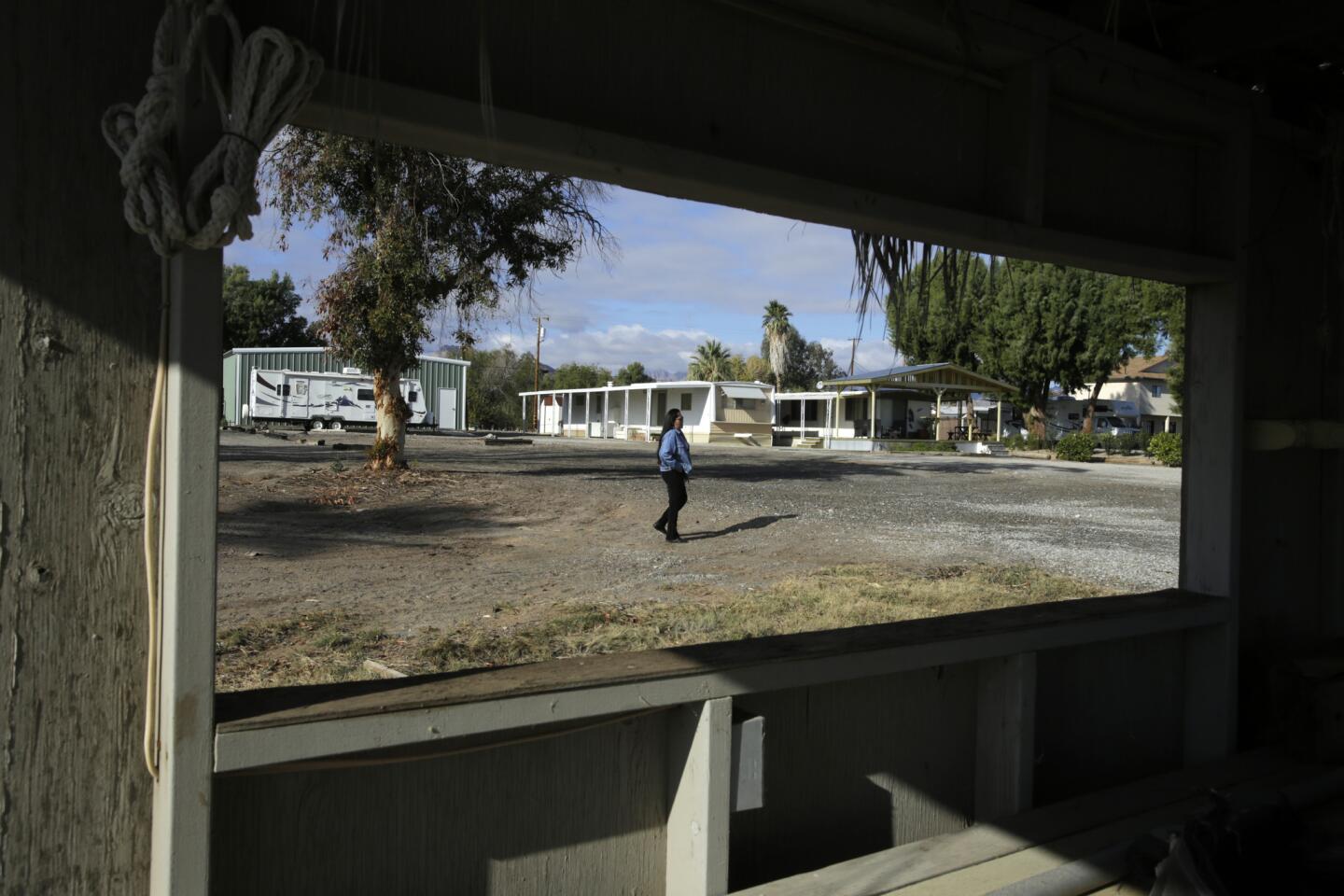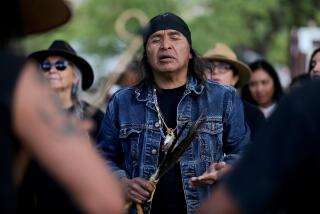Great Read: Holdouts, tribes clash over border of Colorado River reservation
Leaning against a dilapidated gazebo overlooking a lazy bend in the Colorado River, Roger French recalled better times in the nest of mobile homes known as Ranchos Not So Grande.
For 28 years, he lived on the Colorado River Indian Tribes reservation land, surrounded by several hundred others who came here for the solitude, bargain lease rates and serene vistas on the west bank of the river.
“I built this gazebo and planted the trees that surround it,” the 65-year-old electrical engineer said. “My daughter married a guy she met on the river. I enjoyed the best years of my life here.”
But dissension flows through the oasis off Highway 95, a stronghold of non-Indians who have refused to pay rent on their leases for years, claiming the area isn’t actually on the reservation.
In racially tinged chatter, some talk of a coming clash with tribal authorities aiming to remove them by force from land they have spent years and significant personal income improving. (On a recent weekday, a non-Indian resident in the area told a visitor that “the Indians have been eating too much of that peyote lately.”)
To tribal leaders, the holdouts are trespassers itching for a showdown in what they call “anti-Indian zones” — pockets of an 1,800-acre expanse of desert north of Blythe subdivided into 250 leased lots. These days, they rarely travel in certain areas without Riverside County sheriff’s deputies.
The focal point of the standoff is French, who was evicted in 2011 after refusing to pay rent on his lot for 17 years. The eviction was upheld in a tribal court, which ordered French, who lives in Irvine, to pay $250,000 in legal expenses and back rent, plus interest.
Now, with support from Gov. Jerry Brown and California Atty. Gen. Kamala Harris, French is fighting back in a federal court case that many tribal members regard as an assault on their government on the reservation straddling the river in Arizona and California.
French’s lawsuit, filed in U.S. District Court in Arizona, accuses four tribal judges and two tribal council members involved in his eviction proceedings of acting illegally because of the dispute over whether the land belongs to the reservation.
“It’s not tribal land, never has been,” French said.
That kind of talk has made him a local hero among the 30 holdouts who live among an estimated 600 Southern Californians who have settled here full or part time in communities with homespun names — Shaggy Tree, Twin Palms, Paradise Point.
Some came here in the 1940s and 1950s, putting down money on land only to learn later it was part of the Colorado River Indian Tribes reservation. Others felt lucky to sign annual lease permits that allowed them to live along the river for a few hundred dollars a month. Still others simply moved in with friends and relatives.
Rusty Flanagan, 53, who gets by on odd jobs and describes himself as a “noncompliant,” lives near French’s former home.
“Roger is our savior. And Gov. Brown and Kamala Harris, I love them all!” said Flanagan, using a rag to wipe rainwater off a neighbor’s battery-powered golf cart. “If I lose my place here, I’ll be out on the street because I have no income and no family.”
::
At the root of the dispute are opposing views as to whether the reservation boundary is riparian in nature — moving with the river as it changes course over time — or fixed at the high-water mark on the river’s western side as it existed in 1876.
If the boundary is riparian, the reservation excludes land on the California side. If the boundary is fixed, the territory is within the reservation’s jurisdiction.
And if it is fixed, Harris argues, the state has a strong interest in whether tribal gaming could be conducted on the California side of the reservation and whether the rights of non-Indians are being upheld in tribal courts. In addition, Harris warned, if the tribe has jurisdiction over the disputed area, it may exercise claims to Colorado River water, which would “profoundly affect California.”
Harris has submitted an amicus brief in support of French’s motion for a summary judgment. A spokesman for Harris declined to comment except to say she “is representing a client, Gov. Brown.” A spokesman for the governor would only say, “The state is interested in seeing this boundary clarified and this dispute resolved.”
Rebecca A. Loudbear, acting attorney-general for the tribes, was stunned by the move.
“It’s shockingly irresponsible for California to get involved in this case,” she said. “It is also hard to believe that a landlord-tenant dispute over a basic eviction has mushroomed into a federal court case that could have profound impacts on our way of life.”
U.S. District Court Judge John Tuchi has not yet decided whether to accept Harris’ brief. But it already has heightened political and racial tensions in a region polarized by the tribes’ decades-long struggle to evict those who refused to pay rent.
The trouble started in 1969, after then-Interior Secretary Stewart Udall ordered that the reservation’s western boundary conform with a fixed line established in 1876 in order to prevent losses of land because of movement of the river channel.
In 1983, the Bureau of Indian Affairs began approving lease permits on the west bank as part of an effort to encourage economic development and self-reliance.
In the early 1990s, the tribe began raising rental rates by as much as 100%, prompting renters to explore their legal options. They found what they were looking for in U.S. Supreme Court rulings in water rights settlements between California and Arizona that the boundary set in 1969 was not a final determination — but declined to address title to those lands.
“All we want,” French said, “are long-term leases that preserve our constitutional rights and do not include tribal sovereignty or jurisdiction over us.”
Last week, Michael Tsosie, a respected tribal member and historian, submitted a proposed ordinance that calls on the tribal council to remove “illegal aliens and illegal land squatters” from the area by June 1. It also urges the tribe to consider “the use of drones or the building of security fences or walls.”
Tribal Chairman Dennis Patch responded with a carefully worded public statement stressing that the proposed ordinance “reflects the opinions of tribal member Michael Tsosie and was a surprise to the Colorado River Indian Tribes.” He insisted that the reservation had no intention of taking action against the majority of tenants who pay rent.
Tsosie is frustrated with both the holdouts and tribal authorities.
“The ordinance was a message to our tribal government to take care of business — protect our lands and our borders,” he said. “Do your job.”
::
A mile up the road from where French lived, Bob Thweatt manages Twin Palms Resort, a subdivision with 54 tenants, each of whom pays him roughly $220 a month to live on mobile home sites with panoramic views of the river. His gross is about $150,000 a year, he said.
Thweatt said he stopped paying rent on a reservation lease in 1996, after the reservation issued an eviction notice on the business.
“I said, ‘OK, we’re willing to negotiate a lease arrangement, or sell you the business and improvements,’” he recalled. “Instead, they chose to fight — so, I will pack up and leave when someone takes me to court and gets a ruling for me to leave.
“Many people view this movement as an excuse not to pay. But I tried to deal with them. They didn’t want to deal with me.”
Loudbear said the tribe “will be taking legal steps” to take control of the property Thweatt has occupied for two decades.
Over the last five years, the reservation has managed to reduce the number of noncompliant renters from 175 to 30 by initiating eviction proceedings, renegotiating lease agreements and, in some cases, agreeing not to seek restitution from tenants willing to simply walk away.
Sonny and Shar Schubert chose the last option in 2011. “We stopped paying rent in 1994 after we asked the tribe to show us proof that they owned the land — like a pink slip or something — and they couldn’t show it,” said Sonny, 85.
Shar, 75, still talks about the good old days on the river, when she and her husband were known as “Sonny and Cher.”
“We moved out there fat, dumb and happy to live away from the city in early retirement. We went out there to live with nature and relax. So, we got rid of the snakes, scorpions and boulders. We had a piece of paradise: a half-acre with 65 trees, a deck, a private beach and a dock attached to the front lawn.
“I’ve got nothing against Indians, but they did not develop the land on the California side of the river like we did. They didn’t do squat.”
::
The battle has put a cloud over daily routines on the 245,000-acre reservation, an agricultural domain that is home to 4,000 members of four tribes: the Mohave, Chemehuevi, Hopi and Navajo.
They believe their legal rights were guaranteed when the reservation was established by Congress in 1865. Their lawyers say the statute of limitations for challenging a 1969 order by the Interior secretary determining the reservation boundary expired decades ago.
Beyond that, they point out that French voluntarily signed his annual lease permit for about 80 feet of frontage in 1983. The permit described the land as being within the reservation and identified the tribes as the “permitter.”
Herman “T.J.” Laffoon, a member of the tribal council and a defendant in French’s case, wishes the holdouts were more appreciative of the long and troubled history Native Americans are trying to overcome.
He brought his sport utility vehicle to a stop at the entrance to a mobile home park on the western edge of the reservation. Moments later, he was striding toward a reservation marker atop a pole that had been knocked over and partially covered with dirt. The sign declared: “Property Boundary: Indian Reservation Land Behind This Sign.”
“It’s a violation to destroy these signs,” he said, shaking his head in frustration. “But they tear them down all the time around here.”
Twitter: @LouisSahagun
More to Read
Start your day right
Sign up for Essential California for news, features and recommendations from the L.A. Times and beyond in your inbox six days a week.
You may occasionally receive promotional content from the Los Angeles Times.
